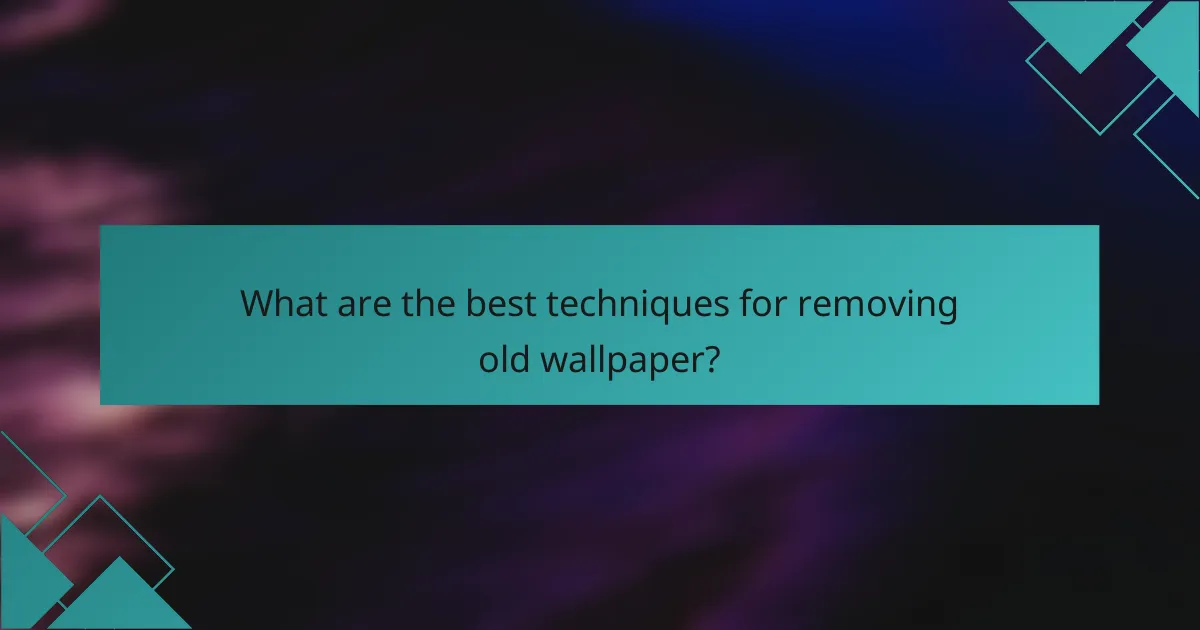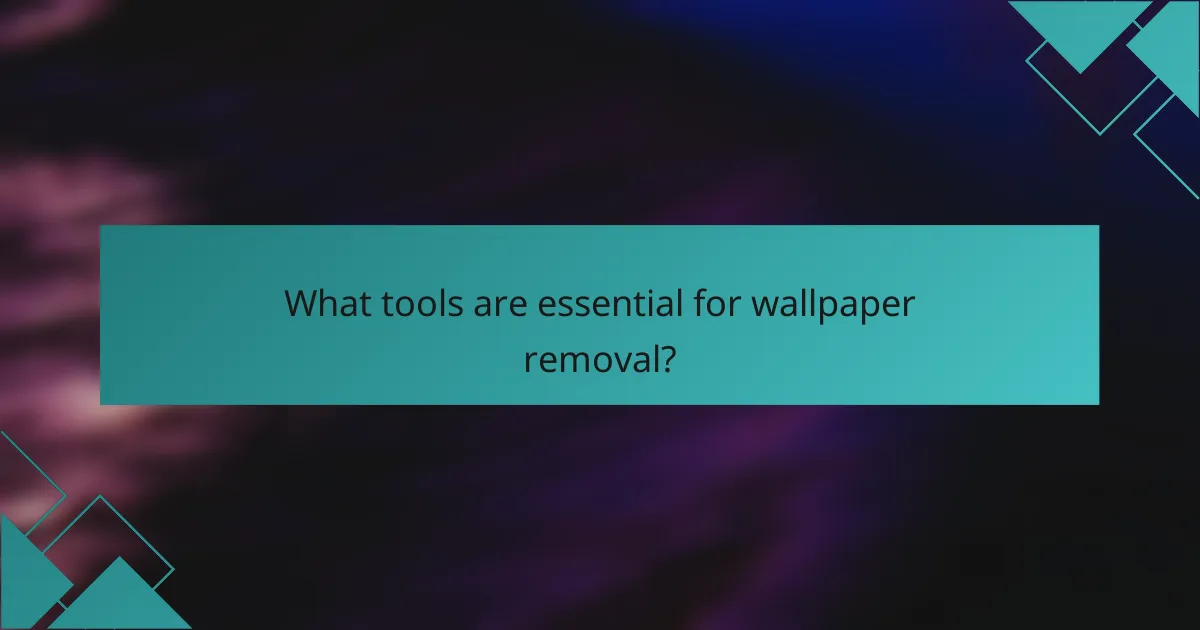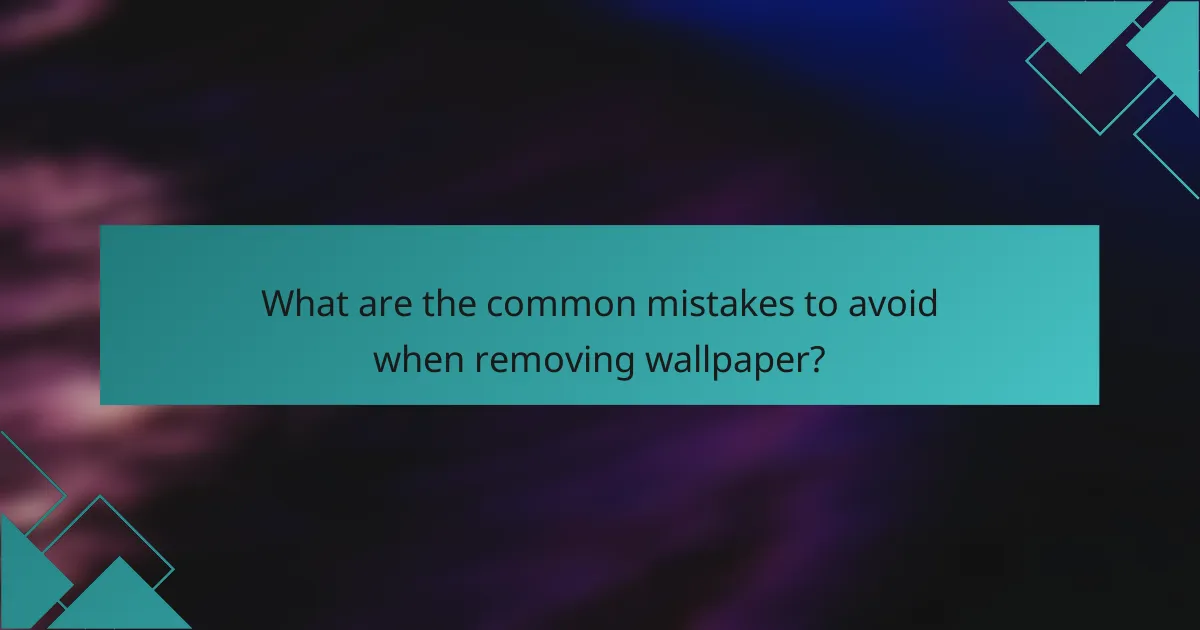Removing old wallpaper can be a challenging task, but with the right techniques and tools, you can protect your walls and achieve a clean finish. Methods such as peeling by hand, using a wallpaper scraper, or applying steam can effectively strip away wallpaper while minimizing damage. To safeguard your walls during the process, be sure to use drop cloths, painter’s tape, and cover electrical outlets for a tidy workspace.

What are the best techniques for removing old wallpaper?
The best techniques for removing old wallpaper include peeling by hand, using a wallpaper scraper, applying steam removal, utilizing chemical removers, and employing a scoring tool. Each method has its advantages and considerations, depending on the wallpaper type and wall condition.
Peeling by hand
Peeling wallpaper by hand is the simplest method, especially for loose or damaged wallpaper. Start at a corner or seam and gently pull the wallpaper away from the wall. If it comes off easily, continue pulling in a steady motion.
However, if the wallpaper resists, this method may not be effective. Be cautious not to damage the wall underneath, particularly with older plaster surfaces.
Using a wallpaper scraper
A wallpaper scraper is a handy tool for removing stubborn wallpaper. After loosening the edges, slide the scraper under the wallpaper to lift it away from the wall. This technique is particularly effective for thicker wallpapers.
Ensure you use a scraper with a comfortable grip to avoid fatigue. Take care to angle the scraper correctly to minimize wall damage.
Applying steam removal
Steam removal involves using a wallpaper steamer to soften the adhesive, making it easier to peel off the wallpaper. This method works well for multiple layers of wallpaper or particularly stubborn types.
Follow the manufacturer’s instructions for the steamer and test a small area first to avoid damaging the wall. Keep the steam head moving to prevent overheating any one spot.
Utilizing chemical removers
Chemical wallpaper removers can effectively dissolve adhesive, allowing for easier removal of wallpaper. These products are typically sprayed or brushed onto the wallpaper and left to sit for a specified time.
Always wear gloves and ensure good ventilation when using chemical removers. Test the product on a small area first to check for any adverse reactions with your wall material.
Employing a scoring tool
A scoring tool creates small holes in the wallpaper, allowing moisture or chemical removers to penetrate and loosen the adhesive. This technique is particularly useful for vinyl wallpapers that are difficult to remove.
Be careful when using a scoring tool to avoid damaging the wall beneath. After scoring, follow up with steam or a chemical remover for the best results.

How can I protect my walls during wallpaper removal?
To protect your walls during wallpaper removal, use drop cloths, painter’s tape, and cover electrical outlets. These techniques help prevent damage and keep your workspace clean.
Using drop cloths
Drop cloths are essential for protecting your floors and catching any debris from wallpaper removal. Use canvas or plastic drop cloths that are large enough to cover the entire area beneath your work.
When laying down drop cloths, ensure they are secured and flat to avoid tripping hazards. Consider using multiple layers if you’re working in a particularly messy area.
Applying painter’s tape
Painter’s tape is effective for protecting edges and corners of walls, ceilings, and trim from damage during wallpaper removal. Apply the tape along the edges where the wallpaper meets other surfaces to create a clean line.
Choose a tape that is easy to remove and won’t leave residue. Press down firmly on the edges of the tape to ensure it adheres well and prevents any moisture from seeping underneath.
Covering electrical outlets
Covering electrical outlets is crucial to prevent moisture and debris from entering the outlets during wallpaper removal. Use outlet covers or painter’s tape to seal them off securely.
Before starting, turn off the power to the outlets for safety. This precaution helps avoid any electrical hazards while you work on the walls.

What tools are essential for wallpaper removal?
Essential tools for wallpaper removal include a wallpaper scraper, steam wallpaper remover, utility knife, and scoring tool. Each of these tools plays a specific role in effectively removing old wallpaper while minimizing damage to the walls.
Wallpaper scraper
A wallpaper scraper is a flat tool designed to lift and remove wallpaper from walls. It typically features a sharp edge that helps to peel away the paper without gouging the wall underneath. When using a scraper, work gently to avoid damaging the drywall or plaster.
Choose a scraper with a comfortable handle for better grip and control. It’s advisable to start at a corner or seam, applying light pressure to gradually lift the wallpaper.
Steam wallpaper remover
A steam wallpaper remover uses steam to loosen the adhesive holding the wallpaper in place. This method is effective for stubborn wallpaper, especially those that have been painted over or are heavily adhered. The steam penetrates the wallpaper, making it easier to peel away.
When using a steam remover, follow the manufacturer’s instructions carefully. Ensure you keep the steam plate against the wall for just a few seconds to avoid damaging the surface. Always wear protective gear to shield yourself from hot steam.
Utility knife
A utility knife is useful for cutting through wallpaper and trimming edges. It can help you create clean lines when removing wallpaper, especially around windows and doors. A sharp blade ensures a smooth cut, reducing the risk of tearing the wallpaper further.
Be cautious when using a utility knife to avoid accidental cuts. Always cut away from your body and use a cutting mat or board to protect your surfaces.
Scoring tool
A scoring tool creates small holes in the wallpaper, allowing moisture from steam or liquid solutions to penetrate and loosen the adhesive. This tool is particularly helpful for vinyl wallpapers, which can be more challenging to remove. Scoring the wallpaper before applying steam or a removal solution can significantly ease the process.
When scoring, apply even pressure and avoid excessive force to prevent damage to the wall beneath. Use the tool in a crisscross pattern for better results, ensuring that the adhesive can effectively break down.

What are the common mistakes to avoid when removing wallpaper?
Common mistakes when removing wallpaper can lead to wall damage and increased effort. Avoiding these pitfalls will help ensure a smoother removal process and protect your walls.
Not testing a small area
Before fully committing to wallpaper removal, it’s crucial to test a small area first. This helps determine the type of adhesive used and the best removal method, whether it’s wetting, scraping, or using a chemical remover.
Testing can prevent unexpected damage, as some wallpapers may peel off easily while others may require more intensive techniques. Always check for any underlying issues, such as mold or water damage, during this test.
Rushing the process
Taking your time is essential when removing wallpaper. Rushing can lead to incomplete removal, which can cause issues when repainting or applying new wallpaper.
Plan for several hours or even days, depending on the size of the area and the type of wallpaper. Patience will yield a cleaner surface and reduce the likelihood of needing repairs later.
Neglecting wall preparation
Proper wall preparation is vital after removing wallpaper. Failing to clean and repair the walls can result in poor adhesion for new paint or wallpaper.
After removal, wash the walls to eliminate any residue, and fill in any holes or imperfections. Sanding the surface lightly can also help create a smooth base for future finishes.

What are the costs associated with wallpaper removal in urban areas?
The costs of wallpaper removal in urban areas can vary significantly based on factors such as the size of the space, the type of wallpaper, and labor rates. Generally, homeowners can expect to pay anywhere from $1 to $3 per square foot for professional removal services, with additional costs for repairs or repainting after the wallpaper is taken down.
Factors Influencing Wallpaper Removal Costs
Several factors can impact the overall cost of wallpaper removal. The complexity of the wallpaper, such as whether it is vinyl or fabric, can affect the time and effort required for removal. Additionally, if the wallpaper has been painted over or is particularly old, it may require more intensive labor, increasing costs.
Labor rates in urban areas tend to be higher than in rural regions, often ranging from $50 to $100 per hour. It’s essential to obtain multiple quotes from professionals to ensure competitive pricing.
DIY vs. Professional Removal
Choosing between DIY and professional wallpaper removal can significantly affect costs. DIY removal can save money, but it requires time, effort, and the right tools, such as a wallpaper scraper, steamer, and adhesive remover.
On the other hand, hiring professionals can lead to quicker results and less risk of damaging the walls. Weigh the potential savings against the value of your time and the quality of the finished job when deciding.
Additional Costs to Consider
After wallpaper removal, there may be additional costs for wall repairs, priming, or repainting. Repairing any damage caused during removal can range from $100 to $500, depending on the extent of the work needed.
It’s advisable to budget for these potential expenses when planning a wallpaper removal project. Always ask for a detailed estimate that includes all associated costs to avoid surprises later on.
